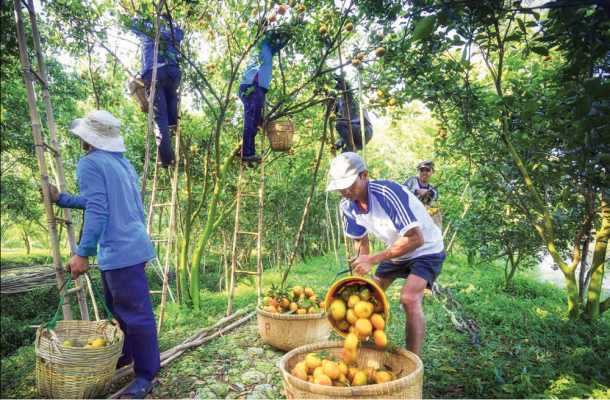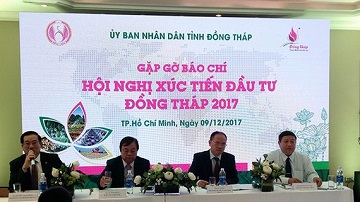The international agricultural value chain has brought initial results after one year of implementation in Tay Ninh. Behind this key model is an interesting story about the journey enhancing the competitiveness of each local region.
FROM THE AWARENESS BREAKTHROUGH…

Provincial Party Secretary Tran Luu Quang
Mr. Tran Luu Quang, Tay Ninh Provincial Party Secretary, once admitted that “Tay Ninh lags behind” when comparing to other provinces of South East Vietnam economic zone. Looking directly at the truth, we see that it is the first movement of perception in the journey of repositioning ourselves. As a border-near province, Tay Ninh has also been involved in the movement to build border economic zone. This model basically went bankrupt, wasting national budgets and local resources. The geographical location of the trans-Asia road creates more mental excitement than economic efficiency when the other side of the border is Cambodia. Reaching surplus turnover with Cambodia, but at some moment in 2010, the trade balance through Moc Bai border is shortfall. Withdrawing the “snorkel” for this 21,300-hectare economic zone is a definitely logical choice.
Tay Ninh is not rich in fossil minerals, both in terms of reserves and value. This invisible disadvantage helps the locals avoid the “curse of resources,” modeled by economists Max Corden and S. Peter Neary in 1982, implying that countries dependent on resources will develop more slowly than other countries. This topic has been discussed by economists for decades, and there is also empirical evidence that the “curse of resources” is anecdotal. A nontransparent system of resource governance is the pathogen. Unfortunately, the S-shaped land is still struggling in the cursed curtain.
Considering the comparative advantage, Tay Ninh has no chance of competing in the industrial sector within the region. Luckily, the pressure to “basically become a modern industrialized country by 2020” has also been lifted after Congress President Nguyen Thi Kim Ngan acknowledged that this goal was “unfulfilled” at the 13th meeting session. This policy has been an important indicator for the central government to evaluate the capacity of the local authority. Raising the share of the industrial sector is the fastest way to reduce the share of the agricultural sector mechanically. As a result, industrial parks and economic zones spring up on agricultural land, regardless of occupancy rates.
Looking at the structure of the three area, it seems that agriculture is the preferred option for Tay Ninh. The area of agricultural land of Tay Ninh reaches 270,000 ha, flat terrain, convenient for mechanization. Significant advantage is that water resources, especially in the context of serious climate change. The network of canals, wetlands receives water from two rivers, Saigon and Vam Co Dong. Upstream of the Saigon River is Dau Tieng Lake with a capacity of 1.45 billion cubic meters. The reserve of underground water has the capacity of 50,000-100,000 m3/g to meet the needs of daily life and irrigation in the dry season. Groundwater is supplemented with an average annual rainfall of about 2,000 mm. This is the foundation for Tay Ninh to develop a variety of tropical agricultural products, in particular fruits and vegetables in the direction of developing hi-tech agriculture.
The southwestern location can be considered as an important factor to help Tay Ninh win the support from the central government to implement the “pilot model”. The government has raised the credit package for hi-tech agriculture to VND 100 trillion (from VND 60 trillion). In addition, the Government pledged to improve the policy system to encourage and create favorable conditions for investment in hi-tech agricultural areas in all regions throughout the country, and especially ” non-compulsory to comply with the overview zoning plan on hi-tech agricultural zones and regions up to 2020, orientated up to 2030 already approved by the Prime Minister in Decision No. 575 / QD-TTg dated May 4th, 2015.” The implication of this message is that the regions named in the plan are no longer just sitting and waiting for funding, but must fairly compete to receive the limited credit.
In particular, the pilot model follows market signals. According to the Vietnam Fruits and Vegetables Association, it is estimated that in 2017 this sector brings the economy $ 3.45 billion from exports, up 40.5% over the same period last year. “Tropical fruits (Vietnam) are agricultural products that many temperate countries cannot provide themselves,” said Raj Sharma, president of Sunrise Orchards (USA). This American investor is particularly interested in the international value chain of the pilot model. Apart from the credit of the Government, the initiative of Tay Ninh is also supported by international investors. A total of nearly $ 2 billion is committed to the Tay Ninh agricultural value chain in the period 2017-2020.
“The province is determined to build hi-tech agriculture with the goal of sustainable development and the improved local’s life”, Mr Quang emphasized. More than a year ago, the Provincial Party Secretary said that Tay Ninh is aiming to build and operate the agricultural value chain in two years.

Tay Ninh leaders met investors who are looking for cooperative opportunities
TO ACTION…
After some business trips, Mr. Quang often take a nap on the moving car. “But when reaching to Tay Ninh I know immediately,” said Mr. Quang comfortably sharing personal experience to illustrate the terrible quality of the local infrastructure. A task force specializing in dealing with procedures related to infrastructure investment in Tay Ninh was established (out of the four special teams that established in recent times). This approach is reminiscent of the Costa Rica government’s campaign to entice Intel in the mid-1990s. The information collected is that the company plans to invest in research and development of center in the Latin America area. One of the strongest candidates is Mexico, which has many advantages from infrastructure, English proficiency, and so on. In these aspects, Costa Rica is completely inferior. The Costa Rican president decided to set up a special authority, located in the Presidential office, to carry out his only mission of persuading Intel into Costa Rica. Institutional changes that meet the needs of the most demanding group of investors in the world are synonymous with the best market standard. From other perspective, Costa Rica has outsourced to institutional reform. The lesson of the success of the Central American nation has inspired many developing countries to attract big company’s investments.

Participating in value chain creates more opportunities for farmers
Continue with the story of the land of the sun. Observed from a relatively reliable index of provincial competitiveness (PCI), Tay Ninh has never reached the top 10. It seems that Mr Quang has also seen that efforts to improve the operation capacity procedurally do not meet development needs. Getting issues related to infrastructure as a focal point is an innovative and effective approach that does not break organizational constraints.
Movements from the authorities have attracted domestic and foreign investors to Tay Ninh. In May, 2017, Lavifood kicked off the Tanifood plant which is expected to process vegetables, tubers and fruits with an investment of VND 1.5 trillion. Up to now, the plant is gradually formed and in August, 2018 will come into operation. This is a factory with leading technology imported from Germany, Italy, Japan, LEED Silver standard and one of the leading factories in Asia in processing vegetables, fruits. Thousands of farmers have been inspired and believed, started crop conversion; Pineapple, lemon fields are formed in hope of changing lives. Mr. Pham Ngo Quoc Thang, Chairman and CEO of Lavifood Corporation, said that because of the belief in Tay Ninh’s leaders, he had built the factory in this province. With the belief in the provincial leaders too, both Mr Pham Nhat Vuong – Chairman of Vingroup – and Mr. Le Viet Lam – Chairman of Sun Group – also turn to Tay Ninh to invest real estate, hotel, tourism project complexes worth to billions of dollars.
Tay Ninh, abbreviated TN, was explained by Secretary of the Provincial Party Committee Tran Luu Quang as Vision (Tầm nhìn in Vietnamese), Responsibility (Trách nhiệm in Vietnamese) and Human love (Tình người in Vietnamese). As for investors, when working with Mr. Quang, they also give another TN, which is Trust (Tín nhiệm in Vietnamese). Therefore, General Director of Viettel Group, Mr. Nguyen Manh Hung, in conversation with the Tay Ninh Provincial Party Secretary before 500 officials and businessmen, said that looking at the eyes of the Provincial Party Secretary, he and many people saw the great credibility. And the greatest credibility is that people here are deeply believing in the leader, the farmers are exhilarating with the new crop.
Source: Nha Quan Ly Magazine (2018).

 Tiếng Việt
Tiếng Việt




